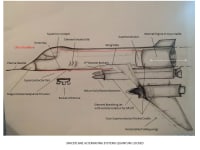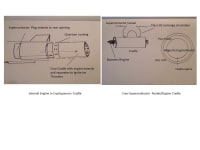LIVING BREATHING SPACEPLANE
Quantum Locking/Flux Pinning
Presented is a Hybrid SpacePlane design using quantum-locking/flux-pinning for long-term space-flight. Interstellar climate suggests type-2 superconductivity is supported for long-term travel. No launch pad or runway needed; vertical take-off/landing capability cut 40% cost. Fuel cost is drastically reduced by “weightless” propulsion and storage via quantum locking.
Current technology enables production while implementing future technologies inspired by SR-71/X-15 in a modified hybrid using LH2/LN2 with magnetic propulsion and alternating adaptable systems.
Solid Rocket Boosters/engines are housed within a cryo-magnetic superconductor cradle (CMSC) through Type 2 superconductors fed through regenerative circulation system that outlines entire vessel using magnetic field lines and flux tubes to carry weight of fuel and engines. Spacecraft is composed of Titanium and HfC/ TaC layered between regenerative cryogenics beneath magnetic skin-Denticles enhancing aerodynamic performance.
Adaptable Element-breathing jet-engines are cryo-cradled in wings. Telescope landing gear can perch semi-vertically or height sufficient for rocket-drones to position to superconductors and enable landing on uneven planetary terrain.
Wing-engines rotate vertically in sync with lift drones to take-off position to sufficient launch height. Wing-Engines begin rotation back to horizontal position as plane body moves 45 degrees upward as engine and plane align to rocket mode. Initial lift-drones and re-usable rocket boosters remain on Earth; a secondary unit of each is housed within vessel for remainder of flight and return. (2-4 boosters)
Wing-engines launch to Mach 3 replaced by Internal-rocket engine to Mach 7-10 as wings retract tucking wing-engines against vessel. Rocket boosters ignite to Mach 20+, disconnecting and returning to earth prior to threshold.
Internal LH2 engine ques as Thermal Nuclear/Magneticplasmadynamic rear Ion Thrusters ignite final push into space. Astro-Pilots are flux pinned at launch and re-entry using magnetic suits in cryo-supercon-cockpit reducing effects of thrust and radiation. Internal-rocket extends outside of vessel to quantum lock and push from behind while encased in cryo-cradle extension. Front propulsion system circulates alternating current through magnetic coil driven by magnetic vortex generator via layered superconductor powered by Denticles. Systems continue to alternate as they reload and regenerate. Wings expand embedded solar sails enable conversion as magnetic rudder used to deflect heat.
Elements are collected and diffracted within vessel. Helium is stored in wing-pits. The problem of extreme heat variations is resolved in an “igloo” effect that also manufactures water and insulates entire vessel.
Magneticplasmadynamic circulating Thrusters feed a Plasma needle that creates a magnetic field around nose and serves as a leader for magnetic propulsion via superconductivity of vessel by ionizing abundant hydrogen gas molecules/atoms creating a moving maglev track.
Magnetic Denticles assist in aerodynamic performance propelling a magnetic vortex generator while also using solar wind as a maglev track for propulsion. Deflection and diffraction maintain temperature and convert unwanted heat into energy using mirrors and solar sails.
Heat shield opens above field generated by magneticplasmadynamic nose to distance itself from vessel. Upon re-entry vessel is glider.
Intake Gills attract ionized molecules of various elements in a superconductor vacuum where they are pinned and identified for conversion to cryogenic state.
Like this entry?
-
About the Entrant
- Name:Antoinette Drago
- Type of entry:individual
- Patent status:none








